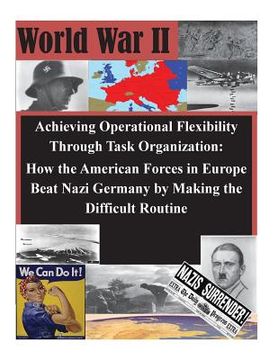Compartir
Achieving Operational Flexibility Through Task Organization: How the American Forces in Europe Beat Nazi Germany by Making the Difficult Routine (en Inglés)
U. S. Army Command and General Staff Col
(Autor)
·
Createspace Independent Publishing Platform
· Tapa Blanda
Achieving Operational Flexibility Through Task Organization: How the American Forces in Europe Beat Nazi Germany by Making the Difficult Routine (en Inglés) - U. S. Army Command and General Staff Col
$ 26.410
$ 36.680
Ahorras: $ 10.270
Elige la lista en la que quieres agregar tu producto o crea una nueva lista
✓ Producto agregado correctamente a la lista de deseos.
Ir a Mis Listas
Origen: Estados Unidos
(Costos de importación incluídos en el precio)
Se enviará desde nuestra bodega entre el
Jueves 08 de Agosto y el
Martes 20 de Agosto.
Lo recibirás en cualquier lugar de Chile entre 1 y 3 días hábiles luego del envío.
Reseña del libro "Achieving Operational Flexibility Through Task Organization: How the American Forces in Europe Beat Nazi Germany by Making the Difficult Routine (en Inglés)"
This study proposes operational flexibility resulted from a unique American way of war developed during the interwar period by veterans of the First World War. Three factors - common doctrine, carefully selected leaders, and an effective organizational structure - provided senior commanders the organizational flexibility they required in combat. Without this flexibility, the Army would have had difficulty executing its breakout from the Normandy bridgehead, pursuing the retreating German forces across France, and quickly thwarting the Nazi offensive in the Ardennes at the end of 1944. The interwar school system and stable doctrine enabled a common understanding on how to solve tactical and operational military problems. The high quality and close-knit officer corps, particularly the Regular Army officers who served in senior leadership positions, facilitated the process of unit integration. The design of large unit organizations, and the staff structure which supported them, greatly simplified the process of moving divisions between units to accommodate the changing situation in the face of an aggressive and adaptable enemy. There is a clear parallel between the roles of U. S. Army World War II era corps and modern divisions, and this study highlights several recommendations to ensure flexibility in future conflicts.
- 0% (0)
- 0% (0)
- 0% (0)
- 0% (0)
- 0% (0)
Todos los libros de nuestro catálogo son Originales.
El libro está escrito en Inglés.
La encuadernación de esta edición es Tapa Blanda.
✓ Producto agregado correctamente al carro, Ir a Pagar.

